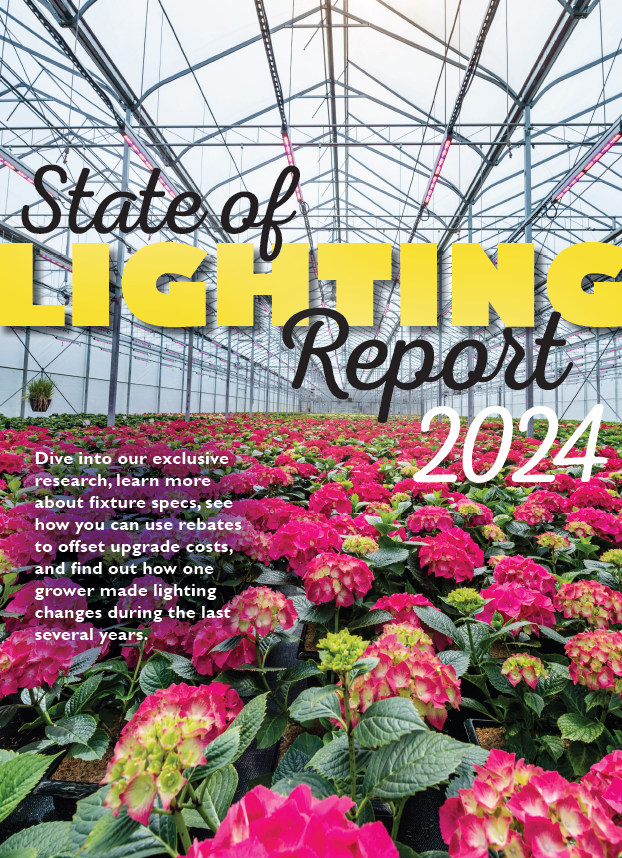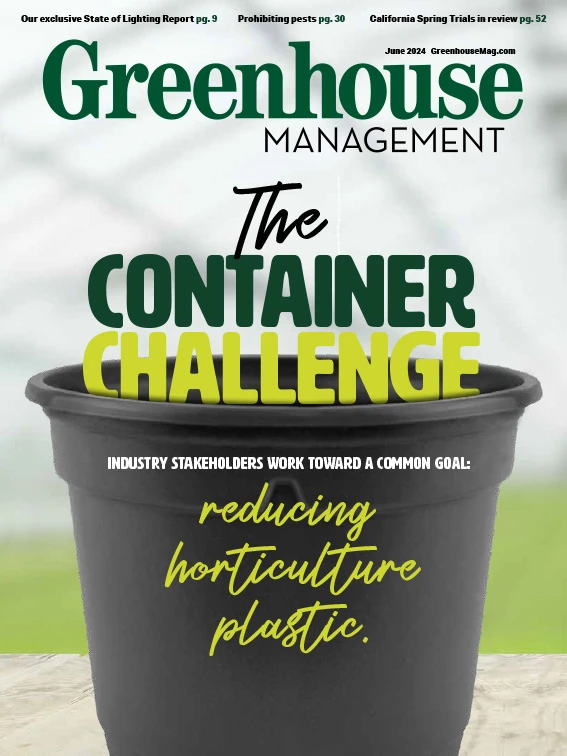
Zeeland, Michigan-based Walters Gardens grows millions of perennial liners each year, which are shipped to independent garden centers, wholesale growers, landscapers and municipalities across the U.S. and Canada. Walters Gardens was an early adopter of LED lighting technology, and we asked Aren Phillips, greenhouse systems manager, to describe the process of trialing and implementing LEDs throughout the operation.
Greenhouse Management: What precipitated the idea to trial LEDs in the first place?
Aren Phillips: The idea came about because we were looking to expand our lighted growing areas, but not drastically increase our energy costs. Commercial LEDs were just hitting the market, so we wanted to test them in our trials department back in 2017. This was our first trial.
GM: How big was the trial, and what crops did you test them on?
AP: The first trial was pretty small compared to what we light now with LEDs. It was a few linear modules that were red and blue — very purple and harsh on the eyes. We trialed LEDs mainly on trade show plants and some plugs for that first trial. We have since moved on to production trials, then finally stock and propagation trials in the last few years.
GM: What were the results that made you a believer in LEDs?
AP: We saw that we did not lose any crop time on finished product with no detrimental effects, although there were a few yellow-leaved varieties that did not like the intense light. We also noticed that we could finish dark-leaved varieties with a true dark color for our customers in cloudy Michigan winters. Before LEDs, we would ship them looking green because of the lack of natural UV light. We have also noticed that our plugs tend to be more compact, but this depends on genus. We have now moved on to lighting some of our stock pots for cutting production and parts of our propagation ranges with no adverse effects.
GM: What are the benefits of LEDs compared to the type of lighting you previously used?
AP: LEDs are becoming so cost effective that there is really no way we that we would go back to HPS lamps. They are highly versatile and can be used for many applications. There are no parts to replace, and warranties are outstanding, depending on the manufacturer. Also, depending on your energy company, there are sizeable rebates available for reimbursement.
GM: How big were the learning curves regarding production when switching to LEDs?
AP: The main learning curve is around the importance of lighting units. It's time to move past lux, lumens and foot candles and use photosynthetic active radiation (PAR), moles and micromoles. It is much more universal and easier to calculate and understand. You want to make sure that you are still hitting your target micromole level and daily light integral (DLI) when replacing or installing new lights.
I would recommend checking out DesignLights Consortium, a nonprofit organization that rates commercial lighting fixtures based on many factors, with photosynthetic photon efficiency being key.

GM: How many square feet of greenhouse space are currently equipped with LEDs?
AP: We are up to about 3 acres of greenhouse space that is now LED lighting. We keep expanding every year with new trials and new types of growing ranges. We are not considering new installations of HPS.
GM: Are they only in propagation areas?
AP: Our propagation areas were actually the last type of ranges that we lit with LEDs, so now we have them there as well. We are now using LEDs in stock, propagation, finishing, holding and trials.
GM: What are your top three pieces of advice for growers thinking about switching to LEDs?
AP: One, to maintain leaf temperature, greenhouses could be kept about 2 degrees warmer due to the lack of infrared heating that you lose from HPS lamps, but it is not necessary. All things considered, I would rather heat with my heaters and light with my lights. It’s just more efficient.
Two, because of the huge number of varieties in ornamental horticulture, tunable spectrum LEDs are really in the realm of R&D. They are just too expensive (you pay for diodes that are off when not tuned to that spectrum). So, if you want to do your own research on the varieties you grow, I would go down this route. If you are looking to light a large area with a high turnover rate, then go with a set spectrum. Ask your supplier for their research and decide from there.
Three, in supplemental lighting, look for LEDs that are dimmable and able to connect to an environmental controls system. They are able to dim when the sun comes out and brighten when it fades, maintaining a constant micromole level. This is really the next step in lighting efficiency and controllability.
For more: waltersgardens.com


Explore the June 2024 Issue
Check out more from this issue and find your next story to read.
Latest from Greenhouse Management
- Anthura acquires Bromelia assets from Corn. Bak in Netherlands
- Top 10 stories for National Poinsettia Day
- Langendoen Mechanical hosts open house to showcase new greenhouse build
- Conor Foy joins EHR's national sales team
- Pantone announces its 2026 Color of the Year
- Syngenta granted federal registration for Trefinti nematicide/fungicide in ornamental market
- A legacy of influence
- HILA 2025 video highlights: John Gaydos of Proven Winners





